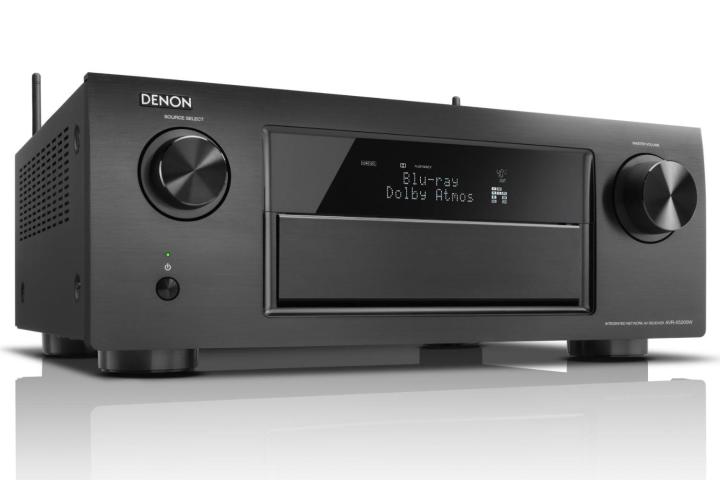
“The X4100 and X5200 are both shipping now with Atmos built-in and ready to go,” said Paul Belanger, D+M Group product manager, adding that the receivers are “the first and only Atmos AVRs available right now.” Denon’s new units have jumped ahead of the likes of Pioneer, Yamaha, Marantz, Onkyo, and others, all of which are bringing Atmos into the home.
Related: All you need to know about Dolby Atmos coming to home theaters
AVR-X4100W 7.2 channel network receiver ($1,400)

Holding up the first line of defense in Denon’s new lineup, the X4100W is an extremely capable component that offers a ton of functionality for the money. Under the hood, the device packs a heavy punch of power, offering 7 channel surround sound with a claimed 125 watts of power per channel. The audio is run through Denon’s Dynamic Discrete Surround Circuit, which handles the bulk of the work, including digital and analog conversions, and DSP.
The X4100W handles nearly anything you can throw at it when it comes to high definition digital decoding, including Dolby TrueHD, and DTS-HD Master Audio, as well as surround sound formats like Neo:X, Audyssey DSX, and Dolby Pro Logic IIz. And in perhaps the biggest news, it also offers compatibility with Dolby Atmos in 5.1.2, 5.1.4 and 7.1.2 configurations, allowing users to add up to 4 overhead Atmos speakers for up to 9 channel sound to step into a hyper-realistic level of surround with Atmos-mixed movies. However, while the receiver can process the Atmos setup, users will need to add a 2-channel power amp to achieve the full 9-channel configuration.
When it comes to network streaming, the X4100W has all the goodies you’d expect in a top-tier receiver, including Wi-Fi with Airplay and DLNA support, as well as Bluetooth for easy connection to smartphone’s and tablets, and onboard Internet radio including Spotify, Pandora, and Sirius XM. The unit also offers remote apps for iPhones, iPads, and Android devices.
Other features include 4K passthrough for top-grade 60Hz content and 4K upscaling, as well as Audyssey MultEQ XT 32 for room calibration. Connections for the unit include 8 HDMI inputs, 3 HDMI outputs for up to three different zones, a front facing USB input for hard drive connection or iPhone input, a phono input, and more. You really shouldn’t need much more than what the X4100W delivers. But if you do…
AVR-X5200W 9.2 channel network receiver ($2,000)

The top-dog of the Denon family, this flagship receiver tacks on all of the spoils of the X4100W, and a bit more. That bit includes more power per side, including a claimed 140 watts per channel, as well as more Dolby Atmos fun to play with. Extra channels allow for an even more expansive Atmos setup, with up to 7 surround channels and 4 Atmos overhead speakers, though, like the X4100W, users will need to add a two-channel power amp into the equation to achieve the full 11-channel output.
Other additional features include Denon’s premium High Current Transistors setup in a monolithic design for even more clarity and punch, and a 13.2 channel pre-out with gold-plated terminals.
For reference, below is a quick breakdown of the key features Denon’s new receivers have to offer:
AVR-X4100W
- D.D.S.C.-HD with AL24 Processing, Denon Link HD
- Built-in Wi-Fi with dual antenna, built in Bluetooth
- Latest HDMI standard with 4K Ultra HD 50/60 Hz Pass-through
- Advanced Video Processing with upscaling up to 1080p and 4k Ultra HD 50/60Hz
- 8 HDMI inputs (incl. 1 front), 3 HDMI outputs (2 main + zone)
- Dolby Atmos (5.1.2, 5.1.4, 7.1.2 configuration)
- Audyssey DSX and DTS Neo:X 9.1ch processing
- Wide support for streaming formats including DSD and AIFF streaming
- AirPlay and DLNA music streaming; Spotify Connect, Pandora and SiriusXM (subscription required)
- Audyssey MultEQ XT32 / Sub EQ HT / LFC (Pro ready)
- Audyssey Dynamic Volume and Dynamic EQ
- Phono input
- 125 watts per channel
- 3 source, 3 zones; 9.2ch processing and 13.2ch pre-out
AVR-X5200W (additional features)
- 140 watts per channel
- Monolithic amplifier design with Denon custom made transistors
- Dolby Atmos (5.1.2, 5.1.4, 7.1.2, 7.1.4, 9.1.2 configuration)
- Audyssey DSX and DTS Neo:X 11.1ch processing
- 11.2ch processing and 13.2ch pre-out; gold-plated terminals
Both of Denon’s premium new receivers hopped over their originally-slated October release, shipping now.
Updated 7/24/2014 at 1:30 PM PST: After publication, representatives for Denon contacted us to modify the power output on the company’s press release from 200 watts to 125 watts per channel for the X4100W, and from 205 watts to 140 watts per channel for the X5200W
Updated 8/25/2014: This post has been updated to reflect that Denon’s new Atmos receivers have begun shipping ahead of their slated October release, making them the first of their kind to hit the open market.
Editors' Recommendations
- What is Dolby Atmos Music, and how can you listen to it at home and on the go?
- Pioneer’s latest budget-friendly Dolby Atmos AV receivers start at $379
- Dolby’s Vegas flex: in person with FlexConnect and Dolby Atmos in-car
- Samsung’s new Dolby Atmos wireless speaker doubles as a picture frame
- Samsung’s flagship HW-Q990D Dolby Atmos soundbar gets Roon support


